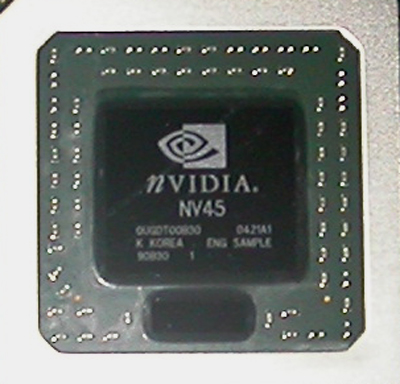NV45's on Package PCIe to AGP HSI
Our discussion brings us to the conclusion that an external bridge is not going to incur a tangible performance hit, but it may cause headaches and added cost on the OEM's side due to complications with additional component layout and parallel bus routing (which certainly complicates pricing and profitability). And the solution is to move the bridge off of the card and onto the GPU package.
The tiny rectangle underneath the GPU is the HSI.
Now, not only is the HSI out of the vendors' hair, but it will also be cooled by the same HSF that sits on the GPU. This GPU looks and feels like a native solution to vendors (and by our benchmarks, it even acts very much like a native solution).
Dropping this thing on the package may seem out of left field, but even Intel has gone the additional-component-on-package route in the past; the original Pentium Pro had on package cache. A precedent like this begs the question: why didn't anyone think of this in the first place? This really makes perfect sense, especially if rumors are true that it's difficult to get a hold of HSI components unless bundled with a GPU.
So what's the down side? Well, there's still the issue of having less than PCIe bandwidth. This isn't going to be an issue for games in their current state, and won't likely be an real bottleneck in the future. Even on AGP, framebuffer read speed was only a couple of hundred MB/s on NVIDIA cards (and even less on ATI). The ability to get good traffic back over the bus has more to do with the GPU than the availability of bandwidth at this point.
The real thing that NVIDIA loses out on with a bridge is the ability to run multiple video streams up and down the PCIe bus with as much theoretical ease as ATI has. We are working hard to come up with some up and downstream PCIe benchmarks that will tell the real story about what is possible with framebuffer reads, and what is possible with video I/O on native and bridged PCIe GPUs.
But for now, we have NV45. No tangible performance impact under current games due to bridging (though a few odd numbers here and there with our current beta drivers), and now no added headache or extra development cost to OEMs over the ATI solution. With all that cleared up, let's head on to the tests.










14 Comments
View All Comments
kherman - Monday, June 28, 2004 - link
How did this get eh NV45 label? Shouldn't this be the NV40p or sum'n?Minotaar - Monday, June 28, 2004 - link
Pentium Pro did NOT have on-package cache. Pentium Pro had On-DIE cache. Pentium 2 took a step backwards and had on-package cache (that huge ugly slot garbage, with the triple fans from OC co's like Glacier? The side two fans cooled cache chips on the side). It wasnt until Socket P3 that on-die cache came back.Thats why celeron happened the way it did. it started off as a p2 with none of the on-package cache. Remember the ol' celly 266 that OC'd to 450, and for some lucky ones 504? Well That was just the P2 card without the cache on the sides - the sides were empty.
Pentium Pro also had the advantage of clock speed cache, whereas P2's cache was bus speed. But I digress. The article has an inconsistancy.
Brucmack - Monday, June 28, 2004 - link
Well, you're not going to gain anything in the near future with PCIe, so if you already have an AGP card, don't bother.It would probably be a good idea to get a PCIe card if you're upgrading to the new Intel chipset though. The boards that have both PCIe and AGP slots are running the AGP slot off of the PCI bus, so there will be a slight performance penalty associated with that.
GhandiInstinct - Monday, June 28, 2004 - link
So is AGP8x faster or better than PCIe, because that's what I got from those earlier benchmarks. Or will drivers and optimizations change that in the future?Basically, is it worth while(money) to purchase PCIe now?